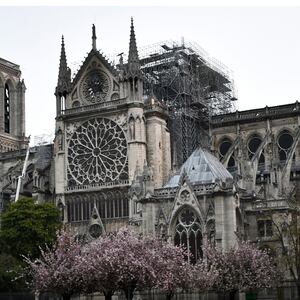When the most famous Gothic cathedral in the world burned this week—smoke and flames billowing out from the spire—I took to Twitter to join the chorus of voices who expressed their heartfelt loss. As a historian, I am all too aware of how vulnerable the remains of the Middle Ages are, and a seemingly eternal building such as Notre Dame is no exception.
Once the fire was under control, and eventually extinguished, the extent of the damage became clear. The outer roof was destroyed, and the spire had collapsed, crushing the inner medieval mason vault as it fell. But apart from where the spire came crashing through, the medieval structures seem to have held, as have the cathedral’s rose windows.
The challenge that now lies ahead is restoring what was lost, and the debate about how this should be done has already started. Should the spire be reconstructed? What materials should be used? Should it look like something from the Middle Ages, or not?
ADVERTISEMENT
If you ask me, in honor of Notre Dame’s history, the new roof needs to be a brand new design, representative of today and not of the past.
Why? Well, the restoration and preservation of historical buildings is based on an idea that there is an original state of things that can be reached if later additions and influences are done away with.
The idea of there being an ‘original state of things’ is also what dominates the worldview of the far right, who use their interpretation of the Middle Ages as a template for how they believe society should be.
While Notre Dame was burning, conspiracy theories began to surface, and declarations were made of the fire portending the end of Western civilization and its Judeo-Christian values. Instead, what was happening was the destruction of a medieval past that has, in all honesty, never existed.
Western civilization is a term that grew out of the creation of history as a topic of study at the universities in England, Germany, and France in the 19th century. In her book History. Why It Matters, historian Lynn Hunt states that “history grew as an academic discipline in tandem with nationalism and a growing conviction of European superiority over the rest of the world.” This conviction led to the West “being portrayed as the source of technical innovation and cultural advancement,” also known as “modernity.”
The origins of “modernity” were found in a distorted interpretation of the Middle Ages, which medievalist Dorothy Kim traces to the German Völkisch movement, also in the 19th century. According to Kim, this movement “rewrote history, drawing from folklore such as that of Brothers Grimm, medieval epics and a dedication to racial white supremacy.”
From these two developments, the term “Western civilization” emerged in the 1890s, but it didn’t come into everyday use until the 20th century was well underway. According to philosopher Kwame Anthony Appiah, the term “West” is used in contrast to something else. During the age of Imperialism it was used in contrast to Asia; during the Cold War in contrast to Communist Europe and the Soviet Union; and today to Latin America, Africa, and Asia (also known as “the Global South”), and the Muslim world. Looking at the world from this point of view, “West” and “Western civilization” come to mean the United States, Europe, and Christianity.
This brings us to the notion of Judeo-Christian values, where once again the Middle Ages are used to make an argument that actually misrepresents the time period. In the eyes of those who promote the ideas of Western civilization and so-called Judeo-Christian values, the Middle Ages stand out as the ideal time period when Europe was a white society united in a homogenous Christian culture led by one single Christian institution.
Such a view of the Middle Ages is inaccurate. In fact, what is considered to be European culture, in the past and today, is an amalgamation of impulses from all over the world. During the Middle Ages, Europe communicated closely with Africa, Asia, and the Middle East using networks that were several thousand years old. Important to keep in mind is that at this point in time, Europe was located at the periphery of the world economic system, whose center lay in the civilizations surrounding the Indian Ocean.
Even though the Catholic Church was the dominating religious institution in the Middle Ages, it did not have monopoly on religion. Medieval Europe was the home of Orthodox Christians, Jews, pagans, and Muslims. The idea of a shared Judeo-Christian medieval origin is immediately contradicted by what we know of the church’s persecution of the Jews living in medieval Europe, perhaps best illustrated by the two sculptures known as Ecclesia and Sinagoga, visible on the façade of Notre Dame itself. These two sculptures represent Christianity’s triumph over Judaism and were a common sight during the 12th and 13th centuries.
History is an ongoing process of human activity. Notre Dame is an example of history being a living, breathing thing. History is not static, and neither is Notre Dame. Or as medievalist Lisa Fagin Davis puts it, “Nothing makes it from the Middle Ages to the 21st century without being transformed along the way.”
Within Notre Dame, we find the accumulation of nine centuries of history. The art, the relics, and the religious objects, whose fate concerned so many while the fire was raging, represent every century of the cathedral’s existence. The spire that fell into a sea of flames on April 16 was a 19th-century addition by Gothic revivalist architect Eugène Viollet-le-Duc after the roof had been without a spire for 50 years.
As a historian who works with material culture, I am well aware of the challenges that come with working on historical buildings, especially those that have been listed as UNESCO World Heritage sites. Nevertheless, Notre Dame’s new roof should be a representation of the architecture of the first decades of the 21st century, more in the spirit of the pyramid at the Louvre than the spire that no longer defines the Paris city silhouette.
An acknowledgement of Notre Dame as the result of worldwide impulses across the centuries can be found in the French government’s decision to put out a global call for architects to participate in a competition to rebuild Notre Dame. In the words of French Prime Minister Edouard Philippe, the new roof of the cathedral needs to be “adapted to the techniques and challenges of our era,” and is called for by “the evolution of heritage.”
A roof of that kind would be a reflection of an event that has added a new scar to an already battle-hardened building.








